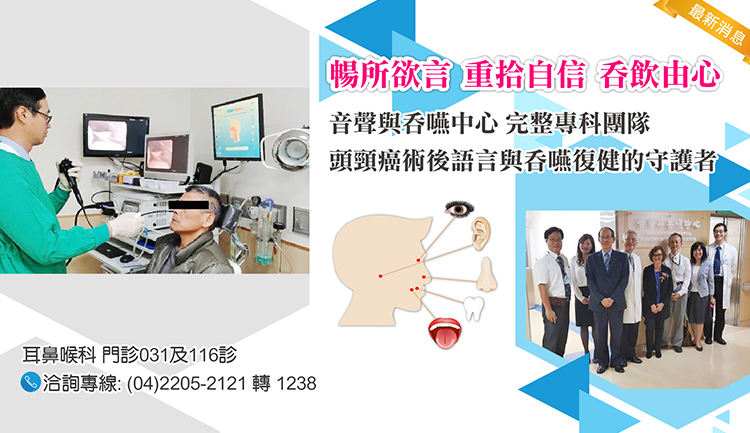Department Introduction
Otorhinolaryngology(ENT),Head and Neck Surgery | Our Speciality
:::


Our Speciality
Functional endoscopic sinus surgery
In early years, the surgical treatment of chronic sinusitis was open Caldwell-Luc surgery, which removes all mucous lining on the maxillary sinus and build a convection hole that connects to the nasal cavity. However, the patient has to suffer greater tissue damage and unnecessary damage to normal sinus mucosa. The more recent functional endoscopic sinus surgery provides a less damaging, higher cure rate option for patients who can’t be cured by medication.
The diseases of frontal sinus and maxillary sinus, such as sinusitis, are due to the narrowing of sinus walls and the blocking of other sinus openings, which are caused by lesions at anterior ethmoid sinus. Surgery is needed only on anterior ethmoid sinus. Other affected sinuses will recover on their own within 2 to 3 weeks after the surgery. We advocate “functional endoscopic sinus surgery” based on this concept and the help of imaging techniques such as computed tomography and magnetic resonance imaging.
Endoscopic sinus surgery applies to general nasal, sinus and nasopharyngeal lesions. It also applies to surgery on organs located around the sinuses, such as the orbit (eye socket) and pituitary gland, which are just a bone plate away from the sinus. With the latest navigation system, sinus endoscopic surgery can also be used to treat complicated recurrent sinusitis and used for skull base surgery.
Endoscopic sinus surgery can be carried out under local anesthesia. More complicated surgery requires general anesthesia. The general sinus surgery only requires about 3 to 4 days of hospital stay. The patient can be discharged when there is no bleeding after the removal of nasal stuffing.
Obstructive sleep apnea
Almost all people with obstructive sleep apnea syndrome snore, and some of who snore suffer from sleep apnea.
Simply put, the cause of snoring is breathing through the narrow upper respiratory tract, making loud sounds. Having sleep apnea for a long time will increase the burden of cardiovascular and pulmonary organs, causing heart disease, high blood pressure and other complications.
When treating sleep apnea patients, many things are required: detailed history and upper respiratory tract pathology check, fiber nasopharyngeal endoscopy, X-ray, craniotomy, nasal resistance, and other tests. The most important and objective diagnostic tool is polysomnography (PSG).
In general, medication is not effective on snoring and sleep apnea. For the combination of snoring and obesity, weight loss is a priority in treatment. In addition, the intake of alcohol and sleeping pills should be avoided. Other internal medical methods include the use of a posterior tongue space maintainer and continuous positive airway pressure (CPAP).
Surgical treatment of snoring is relatively effective. We can perform different procedures on targeted place of stuffing. In addition to the traditional surgery mentioned above, laser and Radiofrequency (RF) are also widely used in the clinical treatment of snoring.

Head and neck cancer
In 1979, only 282 oral cancer cases were recorded in Taiwan. According to the 1996 statistics by Ministry of Health and Welfare (MOHW), oral cancer was already the seventh most lethal cancer in Taiwan. Currently, it ranks sixth nationally and fourth for males. Since 1992, the occurrence and death rate of oral cancer have surpassed nasopharyngeal cancer to become the country's top head and neck cancer. The average age of occurrence has dropped and more than 5,000 new cases are found each year, with more than 2,000 deaths.
Many factors are associated with oral cancer, and the most important one is betel nut chewing. More than 80% of oral cancer patients in Taiwan have the habit of chewing betel nuts, and cancer cells grow mostly on buccal mucosa and tongue. Smoking and alcohol are also closely related to oral cancer. Other reasons include syphilis, excessive sun exposure (lip cancer), chronic nutritional deficiencies, poor oral hygiene, sharp tooth decay, residual roots and improperly made or broken patches (such as dentures, covers, etc.).
In early stages (stages 1 and 2), surgical treatment has a high cure rate. In advanced stages (stages 3 and 4), surgery must be accompanied with postoperative radiotherapy, chemotherapy and target drugs for a better chance. Our hospital has the strongest and most comprehensive medical team in central Taiwan. We provide complete treatment plans or advice based on the individual conditions of patients of oral cancer and other head and neck cancers.
Cochlear implant
A cochlear implant refers to an electronic device that can be surgically implanted into the cochlea. The external acoustic stimulus is amplified and converted into a weak electric current by the receiving device, and the auditory nerve can be directly stimulated to generate auditory sense through this device. Basically, it is different from a traditional hearing aid, which is centered around an amplifier that amplifies the sound and requires residual cochlear hair cells to receive acoustic stimulation. The cochlear implant doesn’t need hair cells. It turns sound into electric currents and directly stimulates the spiral ganglion cells. Tens of thousands of patients are using this device worldwide.

We are the first hospital in central Taiwan to conduct cochlear implant surgery (for a child patient with congenial hearing impairment). However, such device is very expensive, and there are still risks with the procedure. Therefore, doctors must be very cautious when judging whether a patient will benefit from the implant. We have a task force composed of professionals including otolaryngologists, audiologists, speech therapists, special education teachers, and installation technicians. That is why we are able to provide the best diagnosis and treatment calls for children with congenial hearing impairment and patients with acquired severe hearing impairment.
▲
